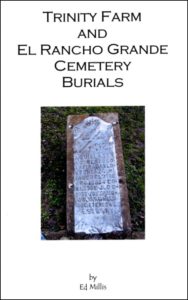Trinity Farms – Rancho Grande Cemetery
LOCATION: The entrance to the cemetery is located south of intersection of Lee Hall St and Arlington Park Dr., between two houses at 5603 and 5519 Arlington Park Drive. The cemetery is hidden behind houses on Arlington Park Drive.
- MAPSCO: 34-W
- GPS: 32.8141760, -96.8494090
- DGS Cemetery Map
- On Google Maps
- On Findagrave
The history and a transcription of burials and information from death certificates for this cemetery was published in 2004 by DGS member Ed Millis. Ed has generously agreed to allow us to make a PDF version of his book (which has been OCR’d, so it is text searchable!) available on our website.
The cemetery consists of two fully fenced locked sections. The eastern section is the Hispanic cemetery. The western section is the African-American cemetery. According to the subject marker, the cemetery is comprised of Hispanic and African-American graves from the 1920’s to the 1940’s.
The cemetery has been surveyed by various groups over the years. Ed Millis reviewed the previous surveys, including a 1992 DGS survey, and then re-surveyed the cemetery. His article, “Trinity Farm and El Rancho Grande Cemetery Burials” was published in the Dallas Journal 2004, Vol. 50, page 3. This database was created from the article with his permission. The section designations used are those assigned by Jay Sowell for the tombstones or by Ed Millis for those without tombstones. Jay Sowell’s cemetery map is included in the article.
Texas Historic Commission Marker
This cemetery represents the last remaining physical reminder of the community of people who worked and lived on a vast commercial farm here known as the Dallas County Trinity Farms from about 1915 to 1946. The farm covered about 3,000 acres of land which had been farmed for many years. Dallas County Trinity Farms was one of several large farms owned by E. P. Harwell of Tulsa, Oklahoma, C. H. Clark of Wichita Falls, Texas, and T. H. Harbin of Waxahachie, Texas. The Trinity Farms Company provided housing, schools, and a general store/commissary for use by the farm laborers and their families. Farm laborers consisted mostly of Mexican citizens, many of whom arrived during the Mexican Revolution, and a sizable number of African Americans. Harbin lived in a large white ranch house and operated the farm which was also known as Rancho Grande. The earliest recorded burials occurred in the early 1920’s. The children of Hispanics and African Americans who worked on the farm attended separate schools. Similarly, the cemetery contains separate sections for Hispanics and African Americans. The last burial occurred in the early 1940’s. The cemetery is maintained by descendants of the families interred here. Sesquicentennial of Texas Statehood 1845 – 1995.
More Information
- Trinity Farm and El Rancho Grande Cemetery Burials by Ed Millis: The Dallas Journal: Volume L, June 2004

